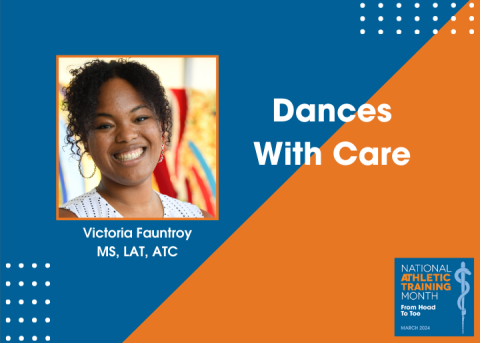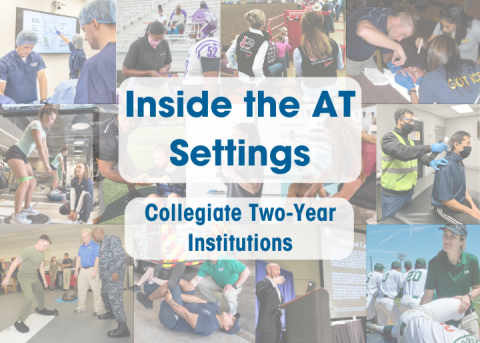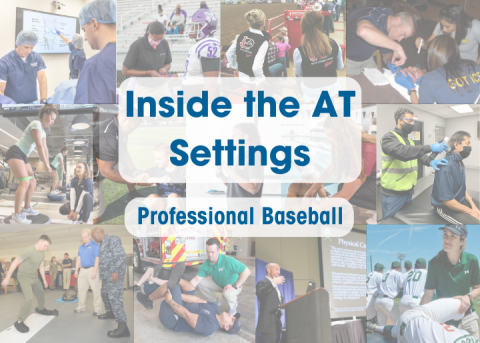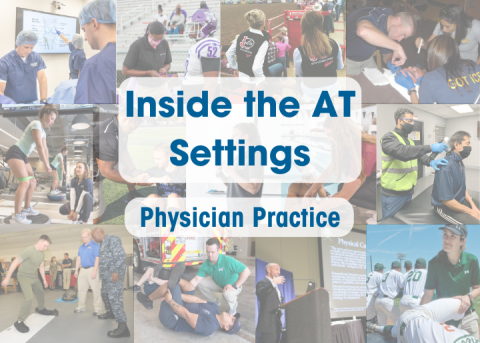
This year, the National Athletic Training Month theme, “From Head to Toe,” highlights the whole-body, whole-person care ATs provide their patients. Throughout March, NATA Now is highlighting members from across the settings. These eight ATs, also featured in the March NATA News, are examples of how ATs are advancing the profession through their direct and indirect efforts.
Victoria Fauntroy, MS, LAT, ATC, discovered her love for treating the whole body through her passion for dancing.
“I started dancing when I was 6 and just loved it,” Fauntroy said. “Since I was a kid, I've always loved the body and learning about it.”
In her senior year of high school, upon finding out that students were shadowing athletic trainers, Fauntroy sought an opportunity to do the same during a football camp. The first two weeks of her experience shadowing the athletic training team cemented her decision to become an AT.
“I just love building relationships with people,” she said. “I got to see at the high school level the relationship that athletic trainers had built with their students. So, I ended up actually staying and shadowing them the rest of my senior year and then went straight into college, into the athletic training program.”
During her AT education at George Mason University, Fauntroy decided she could combine her two loves – dance and sports medicine. With her college advisor’s help, Fauntroy explored dance medicine research.
“I ended up going to a lot of dance medicine conferences and met a lot of different people,” she said. “So, during the spring of my junior year, I had an internship work practicum experience with George Mason School of Dance. So, that was my first experience really with performing artists and from that, I was like, ‘This is it.’”
Fauntroy graduated with a bachelor’s degree in athletic training in 2018 and a master’s degree in exercise, fitness and health promotion in 2020 from George Mason University.
Having immersed herself in a series of research activities, she began an internship with the University of North Carolina School of Arts, which propelled her to her current position. Today, Fauntroy works as the dance athletic trainer for the dance department at Belhaven University, where she teaches the dance kinesiology course and provides medical care to more than 90 dance majors, minors and apprentices.
Outside the athletic training facility and classroom, Fauntroy participates in community outreach to increase the visibility of athletic trainers in the performing arts. She also serves as a member of the NATA Council on Practice Advancement Performing Arts Committee and the International Association for Dance Medicine & Science Intersectionality Task Force and Nominating Committee.
Currently pursuing a Doctor of Athletic Training at Moravian University, Fauntroy also presents on her dance medicine research and has published peer-reviewed journal articles. Her research interests include sleep, health-related quality of life, injury, dance exposure epidemiology and dance for health.
Fauntroy said when she thinks of “From Head To Toe,” this year’s National Athletic Training Month theme, she acknowledges how relevant dance is to the whole body.
“Sometimes when we think of dance, we might think [dancers] only injure maybe their ankle or their knee, but because it's a whole-body craft, anything and everything is subject to getting injured,” she said.
Hence, the importance of providing compassionate care to her patients. While one part of a patient’s body may be injured, Fauntroy treats other related aspects as well. Furthermore, she delves into how the dancers’ minds connect to their body movements to produce performance. So, she also concentrates on mental health.
“Mental health is really big for me, too,” she said. “I think we see a lot of mental health conditions with anxiety and depression, body image and eating disorders. So, I check in with my students every mid-semester to see how they are doing.”
Fauntroy celebrates NATM by advocating for her patients.
“I just want people to understand what dance isn't,” she said. “It’s not any less than basketball, and not any less than soccer. So, I love doing that and I love being able to help advocate for my dancers and teach them how to advocate for themselves.”
Another way Fauntroy has armed herself to support her patients is a pre-participation screening, which usually entails the posture evaluation of freshman and transfer students. This process has evolved into using the selective functional movement assessment (SFMA).
SFMA entails not only looking at the asymmetries of the body, but also analyzing further what the possible causes of the dysfunction are.
“Could it be caused by a joint mobility problem, a muscular or nerve type of mobility problem, or is it a motor control issue?” Fauntroy said.
Through her AT role, Fauntroy has helped her students overcome professional challenges. She has also learned lessons, which fellow and future athletic trainers can glean from.
For instance, when Fauntroy’s patients get injured, the implications go beyond their ability to perform on stage; the situation also affects their academic performance and graduation.
“If we think about soccer players and football players who are here on scholarship, when they get injured, it affects their sport, but they have a psychology major [for instance], so, it doesn't affect their graduation,” Fauntroy said. “But with my dancers, if they can't dance – their classes are technique classes like jazz, ballet – they have to drop the class. This means that they might not graduate on time with their friends. It just creates a little bit of a different pressure.
“I have to get creative in rehab or what I can do with them, and I'm thankful to have faculty who work well with me and the students in trying to facilitate some type of modification.”
Throughout her career, Fauntroy has learned lessons personally and professionally that still make a difference in her life today. One of these is setting boundaries.
“Boundaries are important,” she said. “I think, as athletic trainers – like other medical professionals – we put other people before ourselves. And I think that can be sometimes why we find so much burnout in athletic trainers. So, [one of the] little things I've started to implement is not answering my email over the weekend.”
Hence, Fauntroy tells fellow ATs to embrace rest, compassion for self and continuing education.
“Learn early. Take the vacation,” she said. “Everybody will be OK, but if you are empty, you're not going to be able to give as much as you want to. Also, you're not going to know everything; there's always something that we can continue learning.”





